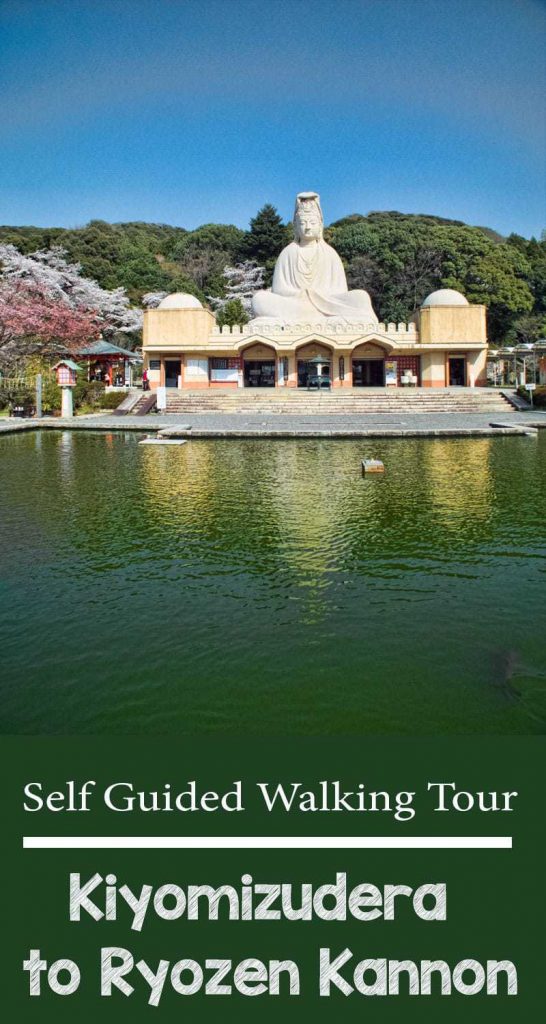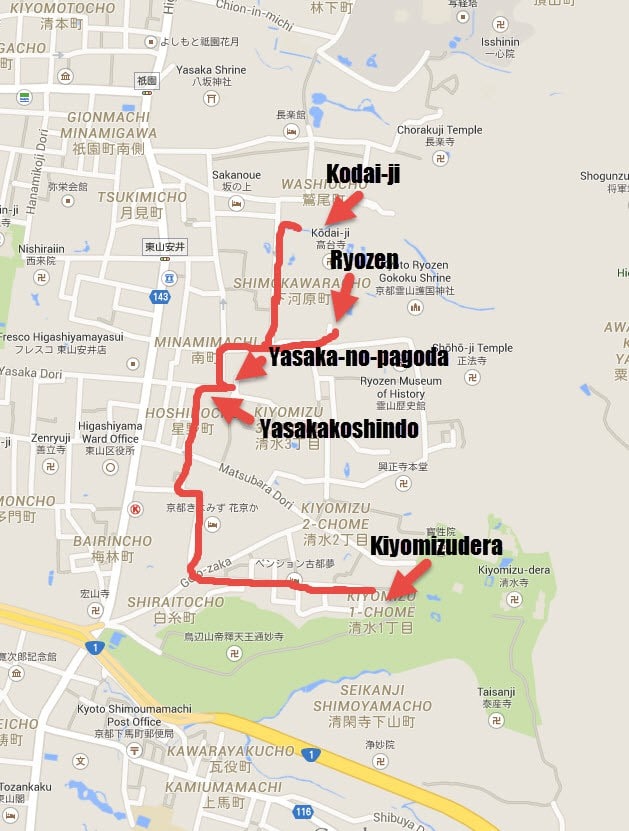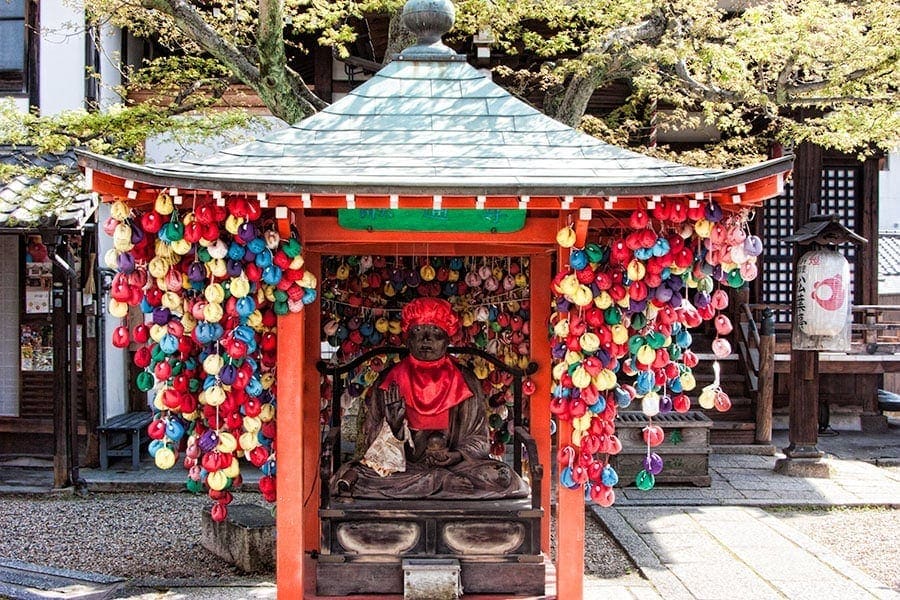This week on our Kyoto photo walk we continue on from Kiyomizudera on the edge of the eastern hills and head north through the quaint and narrow lanes of Higashiyama.

There are lots of old streets, traditional homes, gardens, shrines and shops to explore as you go so it will possibly take you an hour or two to walk through here. If you transit directly from Kiyomizudera to Kodai-ji would be around 1.1km and take you about 15 minutes.
Some of the features of this area, such as the Hokan-Ji temple have a history dating back to the mid 500’s, two centuries before Kyoto was a city. This part of Kyoto is amazing for history buffs, for those with a love of art and architecture, culture and food. There’s pretty much something here for everyone.
One of the first stops we come to is the Buddhist temple of Yasaka Koshin-do also known by its more formal name of Daikoku-san Kongo-Ji Koshin-do. Yasaka Koshin-do is distinguished by the hundreds of Kukurizaru amulets, a type of sarubobo translated as ‘monkey baby’, hanging from the central shrine. These little beanbags represent the monkeys that are bound hand and foot forming a small ball. It means restraint, resisting your desires so your wish will be granted. When your wish comes true you tie your Kukurizaru amulet to a tree or structure within the temple. Up close many of them have writing and dates on them.
Even if you haven’t heard of the Koshin belief before you are probably already familiar with something about it, it’s where the three wise monkeys came from.
See no evil. Hear no evil. Speak no evil.
Watch out as you walk through the surrounding streets and you will see several homes have the little hanging monkeys displayed outside and a few shops have them for sale. Of course, you can also buy the talismans at the temple if you want to, they are for luck and you can keep it with you or tie it to the shrine at the temple, both are equally lucky.
Contining on through the narrow lanes the spring sunshine really brings out the warm colours of the wooden homes and stores. Several times we saw the traditional Japanese style rickshaws called Jinrikishaa which you can just see behing this couple in the photo. Hinrikishaa have re-emerged for the tourist market and are seen mostly in historical areas such as eastern Kyoto, Arashiyama and Miyajima. Japan is one of the few countries in the world that still allows them to be pulled by a person rather than a cycle or being motorised.
The Yasaka-no-Pagoda is nestled amongst the cobbled streets and houses. Despite it’s height relative to the buildings around it you don’t see it from far away which makes it even more impressive when you round a corner and it’s there in front of you.

The Pagoda is part of the Hokan-Ji temple. The temple was established in 588 and claims a historical link to Prince Shotoku, the founder of Buddhism in Japan. The oldest remaining building in the complex is the pagoda which is dated back to 1440 AD.
After the pagoda, it’s not much further to Ryozen Kannon temple. As you turn into the street you can see the large Kannon statue that sits on top of the temple in honour of the fallen Japanese and Allied soldiers of the Pacific war.
The statue is 23.7 metres tall and was cast from concrete in 1955. When you enter the temple grounds and pay your entry fee you are given a lit incense stick, you place this in the incense urn near the shrine entrance and if you wish say a prayer for those that were lost.


Almost behind Ryozen Kannon temple is the Kodai-Ji nunnery, the last stop of today’s photo walk. This was the retreat of Toyotomi Hideyoshi’s widow when she became a nun after her husband’s death in 1598.
Kodai-Ji was originally founded in 838 but is more familiar for its history as a nunnery once Shogun Tokugawa Ieyasu granted the temple to Kitano Mandokoro.
Kodai-Ji is lit up at various times of the year for visitors to enjoy it in the evening. We’ve been to the sakura light-up event and understand it is also lit earlier in March and for the Koyo, autumn leaves. Kyoto, like most of Japan, is very safe to walk around at night so it’s well worth getting out and enjoying events like these after dinner.


Almost behind Ryozen Kannon temple is the Kodai-ji nunnery, the last stop of todays photo walk. This was the retreat of Toyotomi Hideyoshi’s, one of Japans 3 great unifiers, widow when she became a nun after her husbands death in 1598.
Kodai-ji was originally founded in 838 but is more familiar for its history as a nunnery once Shogun Tokugawa Ieyasu granted the temple to Kitano Mandokoro.
Kodai-ji is lit up at various times of the year for visitors to enjoy it in the evening. We’ve been to the sakura light-up event and understand it is also lit earlier in March and for the Koyo, autumn leaves. Kyoto, like most of Japan, is very safe to walk around at night so it’s well worth getting out and enjoying events like these after dinner.
That’s where we’ll leave this weeks photo walk. Next week we’ll continue north towards Yasaka shrine and Maruyama park.
If you found this article useful please consider saving it to Pinterest. It makes it easy for you to find it again, it helps us, and it helps other travellers to find the information they are looking for.


Have you been to Kyoto? If you have please leave a comment below to share your favourite spot to visit, we are always looking for inspiration for our next visit..



Julie
Tuesday 11th of November 2014
Japan and Kyoto in particular is somewhere I've always wanted to go - it is in my very long bucket list! Great post!